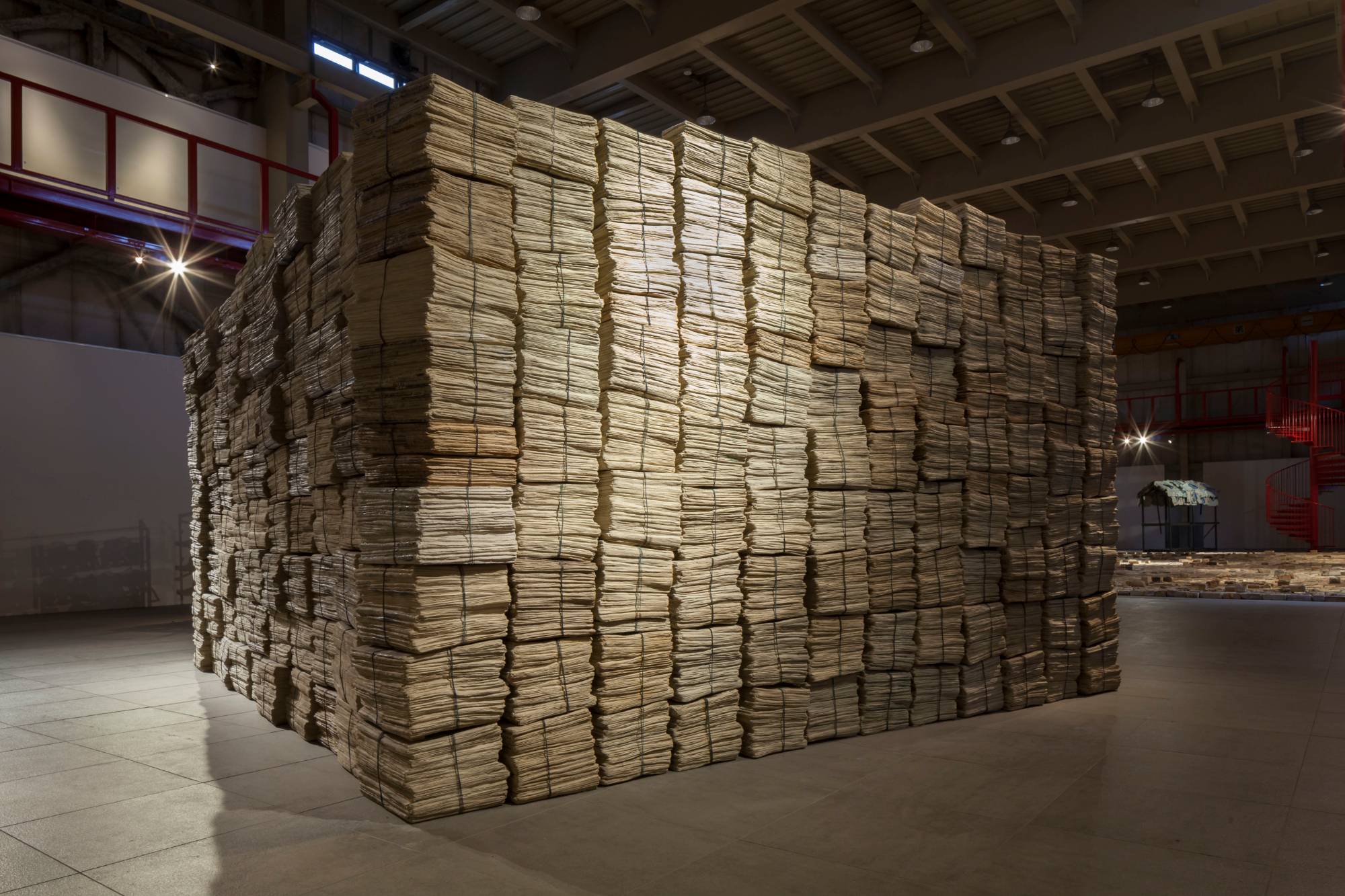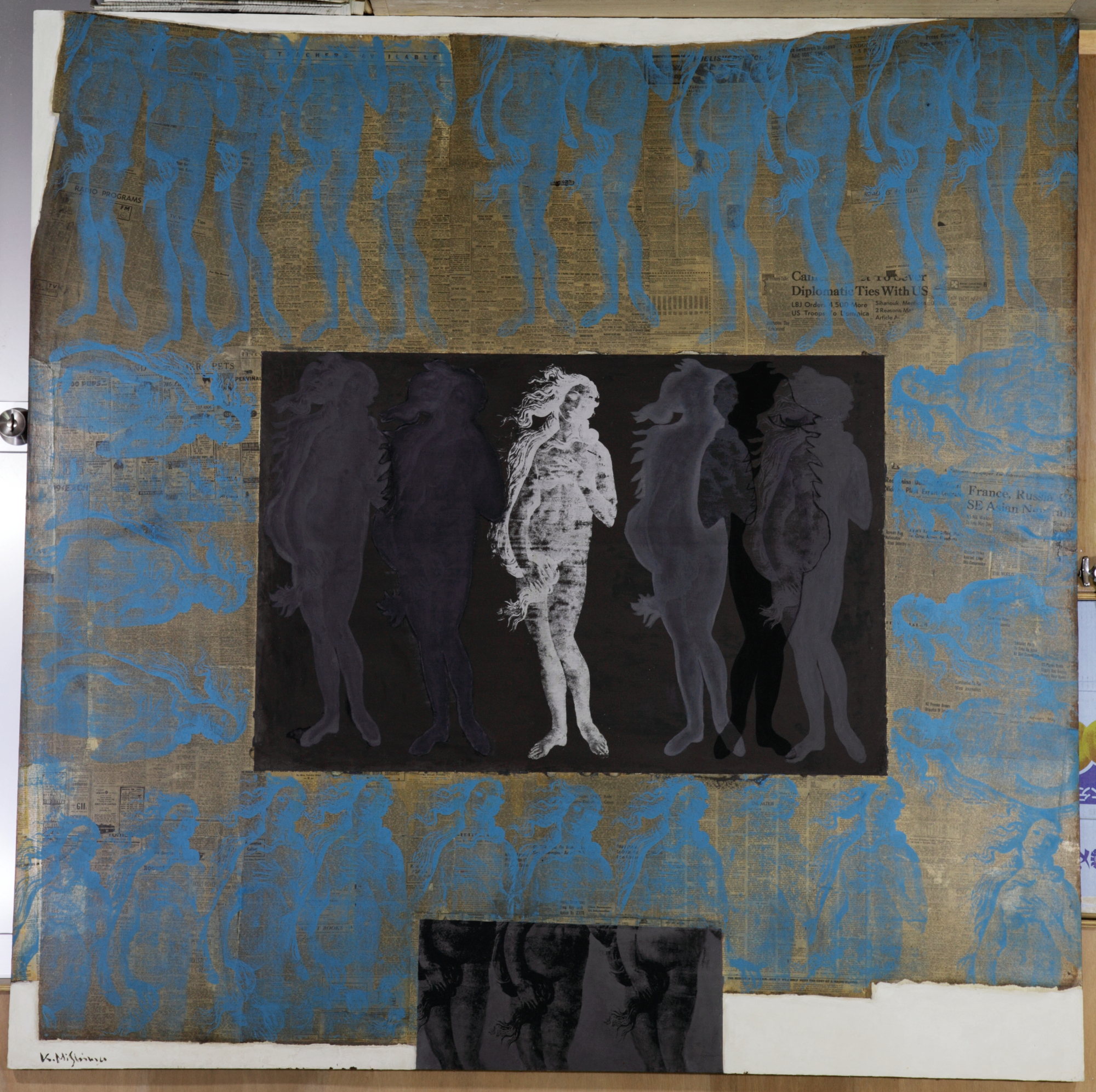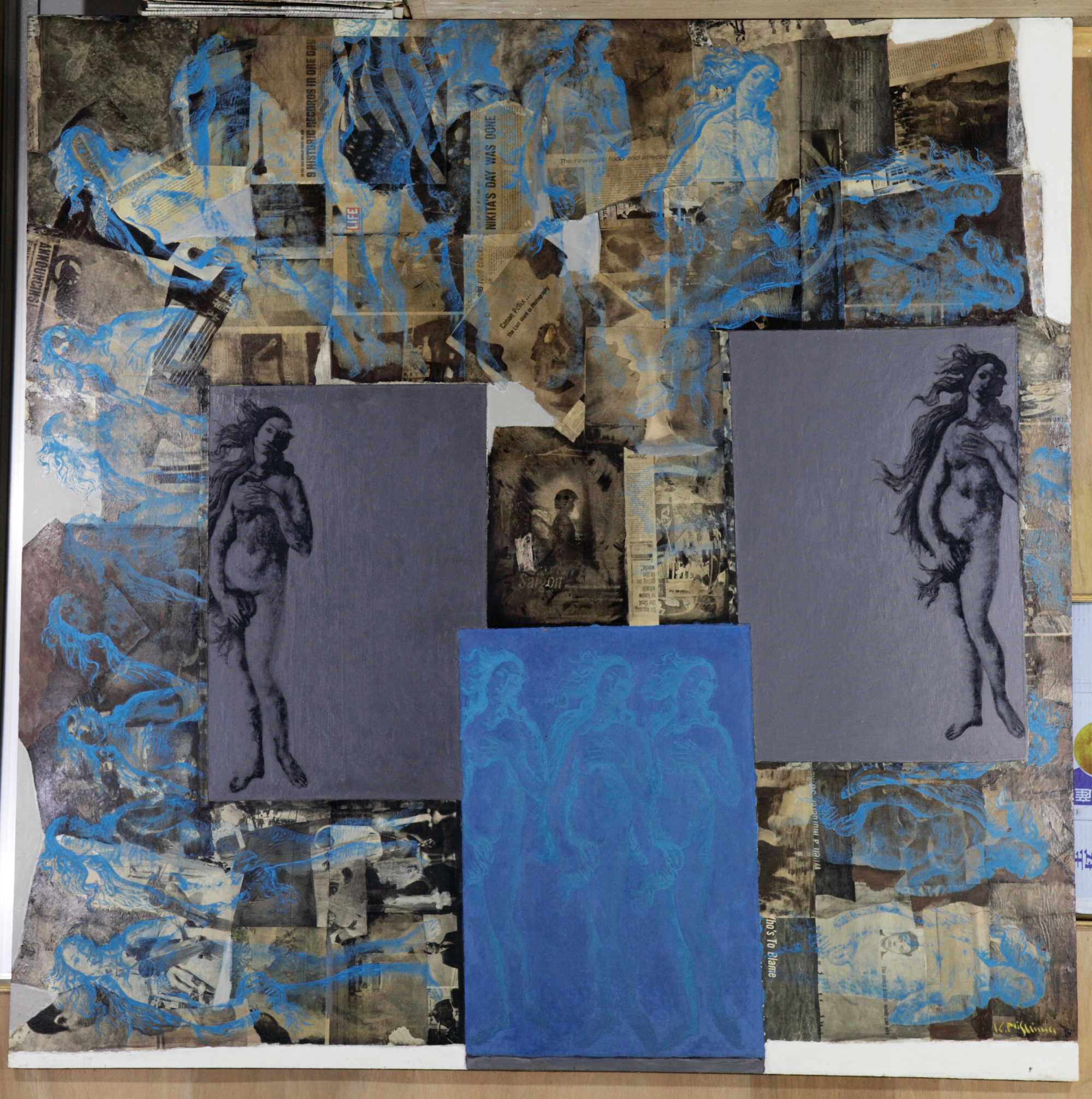三島喜美代
Mishima Kimiyo

作品 92-N
1990-1992年
陶にシルクスクリーン印刷
227×490×390 cm
作家蔵
Work 92-N
1990-1992
Silkscreen on ceramic
227 x 490 x 390 cm
Collection of the artist
作品 92-N
1990-1992年
陶にシルクスクリーン印刷
227×490×390 cm
作家蔵
本作は、陶製の新聞紙、電話帳、マンガなどを、高さ2メートルを越える巨大な直方体に積み上げた作品で、その特異な存在感は私たちを圧倒します。陶という物質は重く、硬く、割れやすいものですが、軟らかく軽い新聞紙を陶に置き換えることで、三島は情報化社会を批評しています。身体を越えるスケールで積み上げられた新聞は、情報の溢れる私たちの社会であり、容易に破壊され崩壊しうるという危機感をはらんだ光景でもあります。三島は、「人類の情報との関わりからくるあらゆる意味での矛盾の一側面を、陶芸化による異化作用を通じて顕在化させ、我々自身に情報の問題を再認識させる一つのきっかけでもあり続けてほしい」と述べています。
Work 92-N
1990-1992
Silkscreen on ceramic
227 x 490 x 390 cm
Collection of the artist
In this work, newspapers, telephone books, and comic books fashioned out of ceramic are piled up into a huge rectangular form over two meters high, overwhelming us with the sheer presence of this unique object. Ceramic is a heavy, hard, and fragile material, but by replacing soft and light newspapers with ceramic, Mishima mounts a critique of our information society. These newspapers, piled up on a scale that exceeds that of the body, also present us with a scene that conveys a sense of crisis that our society, overflowing with information, could easily be destroyed and collapsed. “By defamiliarizing and transforming it into ceramic, this one aspect of the contradictions that arise out of humanity’s relationship with information will become apparent,” says Mishima. “I hope that this will continue to serve as an opportunity for us to reaffirm the problem of information.”

ヴィーナスの変貌 V
1967年
シルクスクリーン印刷、新聞、アクリル絵具、合板
180×180 cm
作家蔵
Transfiguration of Venus V
1967
Silkscreen, newspaper, and acrylic on plywood
180 x 180 cm
Collection of the artist
ヴィーナスの変貌 V
1967年
シルクスクリーン印刷、新聞、アクリル絵具、合板
180×180 cm
作家蔵
Transfiguration of Venus V
1967
Silkscreen, newspaper, and acrylic on plywood
180 x 180 cm
Collection of the artist

ヴィーナスの変貌 VI
1967年
シルクスクリーン印刷、新聞、雑誌、アクリル絵具、合板
180×180 cm
作家蔵
Transfiguration of Venus VI
1967
Silkscreen, newspaper, magazine, and acrylic on plywood
180 x 180 cm
Collection of the artist
ヴィーナスの変貌 VI
1967年
シルクスクリーン印刷、新聞、雑誌、アクリル絵具、合板
180×180 cm
作家蔵
Transfiguration of Venus VI
1967
Silkscreen, newspaper, magazine, and acrylic on plywood
180 x 180 cm
Collection of the artist
本作は、アクリルや油彩で描かれた色面と海外の新聞や雑誌などのコラージュからなる作品で、それぞれの素材が絵画でありながら、日常的な事物の断片でもあるという両義性が重視されています。《ヴィーナスの変貌》と題された2点は、サンドロ・ボッティチェッリ(1445-1510年)の《ヴィーナスの誕生》(1483年頃)の画像がネガとポジを反転させるなどしてシルクスクリーンで反復して刷られています。シルクスクリーンによるイメージの複製には、誰もが知るアイコンの導入でもあったこととあいまって、ポップアートとの相似性を見ることができます。
三島自身は美術の流行や社会問題に意識的に制作していたのではなく、遊びのような感覚で様々なメディアを用いて制作してきました。しかし、それらはそれぞれの時代を真摯に表現した作品であったことから、結果的に美術の潮流や、環境問題などの現代社会の問題との親和性を見つけることができる作品になっているのかもしれません。
These works consist of colored surfaces painted in acrylic or oil paint and collages of foreign newspapers, magazines, and other items. Emphasized here is the ambiguity of each material, which functions as both painting and a fragment of an everyday object. In these works titled Transfiguration of Venus, the image from The Birth of Venus (c. 1483) by Sandro Botticelli (1445-1510) is printed repeatedly by silkscreen with the negative and positive planes reversed. In these reproductions of image transfers by silkscreen, coupled with the fact that this gesture also introduced an icon known to everyone, we can see a certain similarity with pop art.
Mishima herself did not consciously tackle art trends or social issues, but rather used a variety of media in a playful way. Since these works were sincere expressions of their respective eras, however, they may have resulted in works that find an affinity with art trends and contemporary social issues such as environmental problems.
アーティスト一覧ARTISTS
- Etel Adnan|エテル・アドナン
- Phyllida Barlow|フィリダ・バーロウ
- Anna Boghiguian|アンナ・ボギギアン
- Miriam Cahn|ミリアム・カーン
- Lili Dujourie|リリ・デュジュリー
- Anna Bella Geiger|アンナ・ベラ・ガイゲル
- Beatriz González|ベアトリス・ゴンザレス
- Carmen Herrera|カルメン・ヘレラ
- Kim Soun-Gui|キム・スンギ
- Suzanne Lacy|スザンヌ・レイシー
- Mishima Kimiyo|三島喜美代
- Miyamoto Kazuko|宮本和子
- Senga Nengudi|センガ・ネングディ
- Nunung WS|ヌヌンWS
- Arpita Singh|アルピタ・シン
- Robin White|ロビン・ホワイト

